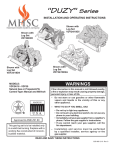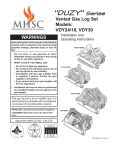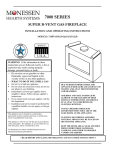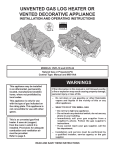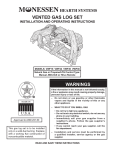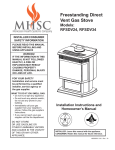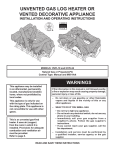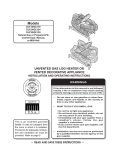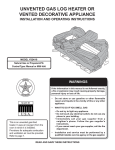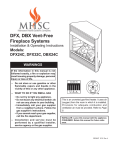Download Monessen Hearth Series Operating instructions
Transcript
INSTALLATION AND OPERATING INSTRUCTIONS
Shown with
Log Set
VDY30D3R
Shown with
Log Set
VDY24/18D2
Shown with
Log Set
VDY24/18D4
MODELS: VDY24/18 • VDY30
Natural Gas or Propane/LPG
Control Type: Manual or Milli-Volt
WARNINGS
If the information in this manual is not followed exactly,
a fire or explosion may result causing property damage,
personal injury or loss of life.
–
Do not store or use gasoline or other flammable
vapors and liquids in the vicinity of this or any
other appliance.
–
WHAT TO DO IF YOU SMELL GAS
• Do not try to light any appliance.
• Do not touch any electrical switch; do not use any
phone in your building.
• Immediately call your gas supplier from a neighbor's
phone. Follow the gas supplier's instructions.
• If you cannot reach your gas supplier, call the
fire department.
Approved to ANSI Z21.60
This gas log set is to be installed only
in a solid-fuel burning fireplace with a
working flue constructed of noncombustible material.
–
Installation and service must be performed
by a qualified installer, service agency or the
gas supplier.
READ AND SAVE THESE INSTRUCTIONS
TABLE OF CONTENTS
Important Safety Information ........................ 3
Getting Started ............................................... 4
Product Specifications ................................... 5
Product/Features Specifications ................... 6
Placement in a Fireplace with a Restrictive
Barrier ........................................................ 7
Operating Instructions ................................. 18
For Your Safety Read Before Lighting ...... 18
Manual Control Lighting Instructions ......... 18
Milli-Volt Control Lighting Instructions ....... 19
Safety Instructions for Manual Control without
Pilot ........................................................... 20
Optional Remote Receiver ........................... 21
Installation ....................................................... 8
Cleaning and Servicing ................................ 22
Connecting the Gas......................................... 9
Illustrated Parts List ..................................... 23
Electrical Wiring (Millivolt).............................11
Troubleshooting ........................................... 27
Log Placement .............................................. 12
Warranty ..........................................Back Cover
Fireplace Draft Test ...................................... 16
Flame Appearance ........................................ 17
2
32D1999
IMPORTANT SAFETY INFORMATION
INSTALLER
Please leave these instructions with the owner.
OWNER
Please retain these instructions for future reference.
IMPORTANT
Any modification to this gas log set or its controls can be dangerous. Improper
installation or use of the gas log set can cause serious injury or death from fire, burns,
explosion or carbon monoxide poisoning.
1. The installation, combustion and ventilation air must
conform with local codes or, in the absence of local codes,
with the National Fuel Gas Code, ANSI Z223.1.
2. This unit complies with ANS Z21.60-1996 • CGA 2.26M96 Decorative Gas Appliance for Installation in SolidFuel Burning Fireplace. The natural gas manual control
unit without the pilot complies with IAS U.S. 7-94. Manually Lighted, Natural Gas Decorative Gas Appliance for
Installation in Solid-Fuel Burning Fireplaces.
3. Installation and repair should be done by a qualified service person. Monessen Vented Gas Logs must be installed
only in a solid-fuel (wood) burning fireplace which can
only be constructed of non-combustible material, with
minimum venting requirements, see installation section.
4. To prevent malfunction, gas log set and flue should be
cleaned at least annually by a professional service person.
More frequent cleaning may be required due to excessive
lint from carpeting, etc. It is imperative that control compartments, burners and circulating air passageways be
kept clean.
5. Correct installation of the ceramic fiber logs, and annual
cleaning are necessary to minimize problems with sooting. See log placement instructions for proper installation.
6. A damper clamp must be installed to provide the minimum
permanent vent opening to vent flue products, Refer to
installation instructions.
7. Never burn solid fuels in a fireplace where a gas log set
is installed.
8. This appliance must not be used with glass
doors in the closed position. Provisions for adequate
combustion air must be provided, adequate combustion
air usually results in all flames curling into the fireplace
away from screen and up the flue.
32D1999
9. Keep room area clear and free from combustible materials,
gasoline and other flammable vapors and liquids.
10. Children and adults should be alerted to the hazard of
high surface temperature and should stay away to avoid
burns or clothing ignition.
11. Young children should be carefully supervised when they
are in the same room with the gas log set in operation.
12. Do not place clothing or other flammable material near
the fireplace when the gas logs are in use.
13. Do not use this gas log set if any part has been underwater.
Immediately call a qualified service technician to inspect
the gas logs and replace any part of the control system
and any gas control which has been under water.
14. The gas log set and its individual shutoff valve must be
disconnected from the gas supply piping system during
any pressure testing of the gas supply piping system at
test pressures in excess of 1/2 psig (3.5kPa).
15. The gas log set must be isolated from the gas supply
piping system by closing its individual manual shutoff
valve during any pressure testing of the gas supply piping system at test pressures equal to or less than 1/2 psig
(3.5kPa).
16. FOR MASSACHUSETTS RESIDENTS ONLY:
Installation of this vented gas log in the Commonwealth
of Massachusetts requires the damper be permanently
removed or welded in the full open position. In addition, a
naturally vented gas log may not be installed in a bedroom
or bathroom in the commonwealth of Massachusetts.
WARNING
WARNING
Read these instructions carefully before installing or trying to operate this gas log set.
This appliance is for installation only in
a solid fuel burning fireplace (masonry
fireplace or manufactured fireplace)
3
GETTING STARTED
MAKE SURE YOU HAVE RECEIVED ALL PARTS:
Check your packing list to verify that all listed parts have been received. You should have the following:
BURNER - GRATE ASSEMBLY 24/18, 30
• Burner and Grate Weldment Assembly
• Lava Rocks (x2)
• Glowing Embers (Rock Wool)
• Damper Clamp
• Installation /Operating Instructions
• Masonry Screws (2)
•
3/8"
Aluminum tube with 3/8" 90° elbow, 1/2" to 3/8" tubefitting
CERAMIC FIBER LOGS 24/18, 30
CAUTION
• Individual Logs
• Installation Instructions
• Handle the gas log burner assembly by the grate only. Do not pick the unit up by the
burner.
• Gloves are recommended when handling ceramic fiber logs to prevent skin irritation
from loose fibers. Logs are fragile — handle with care.
Carefully inspect the contents for shipping damage. If any parts are missing or damaged, immediately inform the dealer
from whom you purchased the appliance. Do not attempt to install any part of the appliance unless you have all parts
in good condition.
ITEMS REQUIRED FOR INSTALLATION
Ensure that the following items are available before proceeding with installation:
• External regulator (for propane/L.P.G. only)
• Manual shutoff valve
• Piping which complies with local codes
• Pipe wrench
• Tee joint
• Pipe sealant approved for use with propane/L.P.G. (Resistant to sulfur compounds)
• Drill with masonry bit (for mounting to the floor)
4
32D1999
PRODUCT SPECIFICATIONS
NATURAL GAS
Manual Pressure
Regulator Pressure Setting:
Gas Inlet Pressure:
Milli-Volt Pressure
4" w.c.
Max. 10 1/2" w.c.
Min. 6" w.c.
Regulator Pressure Setting: 4.0" w.c.
Gas Inlet Pressure:
Max. 10 1/2" w. c. • Min. 6" w.c.
Model Number
Pilot
Control Type
Gas Rate Min BTU/Hr
VDY24/18NMP
Yes
Manual (Thermocouple)
50,000
VDY24/18NM
No
Manual
50,000
VDY24/18VP
Yes
Milli-Volt (Thermopile)
50,000
VDY30NMP
Yes
Manual (Thermocouple)
65,000
VDY30NM
No
Manual
65,000
VDY30NVP
Yes
Milli-Volt (Thermopile)
65,000
PROPANE/LPG
Note: An external regulator is required to reduce supply pressure to a maximum of 13" w.c.
Manual Pressure
Regulator Pressure Setting:
Gas Inlet Pressure:
Model Number
Milli-Volt Pressure
10" w.c.
Maximum 13" w.c.
Minimum 11" w.c.
Regulator Pressure Setting:
Gas Inlet Pressure:
10" w.c.
Maximum 13" w.c.
Minimum 11" w.c.
Pilot
Control Type
Gas Rate Min BTU/Hr
VDY24/18PMP
Yes
Manual (Thermocouple)
50,000
VDY24/18PVP
Yes
Milli-Volt (Thermopile)
50,000
VDY30PMP
Yes
Manual (Thermocouple)
65,000
VDY30PVP
Yes
Milli-Volt (Thermopile)
65,000
IGNITION CONTROLS
Piezo ignitor allows ignition of the pilot without the use of matches or batteries.
Manual control with pilot has three (3) positions:
OFF - All gas to the gas logs is shut off at the valve.
IGN - Valve position to light/maintain a standing pilot.
ON - Valve position to light/maintain the gas burner.
Manual control without pilot has two (2) positions:
OFF - All gas to the gas logs is shut off at the valve.
ON - Valve position to light/maintain the gas burner.
Milli-Volt control with pilot has three (3) positions:
OFF - All gas to the gas logs is shut off at the valve.
IGN - Valve position to light/maintain a standing pilot.
ON - Valve position to light/maintain the gas burner.
32D1999
5
PRODUCT / FEATURES SPECIFICATIONS
MANUAL SERIES (W/ PILOT AND W/O PILOT)
Model
A
B
C
D
VDY 24/18
17
13 1/2
26
16
23
1/2
32
16
VDY 30
13
A
D
MILLIVOLT SERIES (W/ PILOT)
Model
A
VDY 24/18
VDY 30
18
24
B
C
D
13
1/2
26
16
13
1/2
32
16
C
B
Figure 1 - Minimum Hearth Dimensions
In compliance with IAS U.S. 7-94, ANS Z21.60-1996 • CGA 2.26-M96 and National Fuel Gas Code, Section 6.6
BEFORE INSTALLING THE APPLIANCE:
Damper Stop
• Turn off gas supply to masonary fireplace or manufactured wood
burning firebox.
• Have the fireplace floor and chimney professionally cleaned to remove ashes,
soot, creosote or other obstructions. Have this cleaning performed annually
after installation.
Damper
Figure 2 - Damper Stop
Installation
39 doors
sq in located on floor or wall of
• Seal any fresh air vents or ash clean-out
fireplace. If not, drafting may cause pilot outage or sooting. Use a heat-resistant sealant.
INSTALL AND OPERATE THE APPLIANCE AS DIRECTED IN THIS MANUAL.
DAMPER STOP INSTALLATION:
A damper stop is provided with the unit. The damper stop must be installed as shown in (Figure 2) to prevent full closure of
the fireplace damper blade and provide a minimum flue opening, per table below.
Should the clamp not fit, or provide the required permanent opening from the table have the damper blade cut to provide
minimum permanent opening or a permanent stop installed.
Installation of this vented gas log set in the Commonwealth
of Massachusetts requires the damper be permanently
removed or welded in the fully open position. In addition, a
naturally vented gas log may not be installed in a bedroom
or bathroom in the Commonwealth of Masasachusetts.
6
Chimney
Height
VDY24/18N
VDY30N
6'
51 sq in
64 sq in
8'
51 sq in
64 sq in
10'
51 sq in
64 sq in
15'
39 sq in
51 sq in
20'
39 sq in
51 sq in
30'
39 sq in
51 sq in
WARNING
FOR MASSACHUSETTS RESIDENTS ONLY
The fireplace and gas logs function
as a system. If the fireplace is spilling
into the room (check with a match or
smoke stick). Reposition the damper
clamp until a positive draft is obtained,
by opening the damper. If negative
pressure in the home prevents having
a positive draft contact your dealer.
Minimum Opening Area of Chimney
Damper for Venting
32D1999
PLACEMENT IN A FIREPLACE WITH A RESTRICTIVE BARRIER
IMPORTANT INFORMATION FOR THE INSTALLATION OF THIS GAS LOG SET
The following are guidelines for placing a gas log set in a fireplace that has a restrictive barrier along the bottom front opening of the fireplace. Some examples of barriers are glass/screen door frames and sunken/recessed fireplaces.
Height of Restriction (X) Minimum Depth of Fireplace/Firebox
131/2"
15"
15"
ANY BARRIER GREATER THAN THREE INCHES (3") PLACED IN FRONT OF
THE GAS LOG SET IS NOT RECOMMENDED BY THE MANUFACTURER.
No restriction
0 to 1.5"
Greater than 11/2" to 3"
Greater than 3"
Glass door frames
with adjustable
louvers should have
the lovers fully open
while the unit is in
operation.
The log set should be
placed against or as near
as possible to the rear wall
of the fireplace/firebox.
Height of restrictive barrier X
caused by glass door frames,
recessed fireplaces, etc. from
the base or bottom surface of the
unit. (Refer to Table).
Depth of fireplace/firebox.
(Refer toTable).
WARNING
Figure 3 - Reference Drawing of a Log Set in an Enclosure
Barriers such as the bottom of a glass door frame placed in front of a gas log set can
change the air flow characteristics of the fireplace which in turn can cause the unit to
overheat and malfunction. Any deviation from the installation guidelines on this sheet
will potentially void the warranty.
NOTE: Non combustible material such as refractory brick may be used to line the floor of the fireplace
in order to raise the height of the gas log set in relation to a restrictive barrier. If the unit is raised, THE
MINIMUM HEIGHT DIMENSION LISTED IN THE HOMEOWNER’S MANUAL MUST NOT BE EXCEEDED.
NOTE: If the log set is equipped with a remote receiver, a restrictive barrier may reduce the battery life
by increasing the ambient temperature inside the fireplace. Placement of the receiver outside of the
fireplace will extend the battery life.
32D1999
7
INSTALLATION
WARNING
PLACING AND SECURING APPLIANCE
You must secure the gas log heater to
the fireplace floor. Properly securing
the grate prevents movement of
the entire unit when you adjust the
controls. Grate movement could cause
a gas leak.
ASSEMBLY PROCEDURE
1. Center the gas log unit in the fireplace or firebox. Make certain the front feet of the grate sit inside the front edge of the
fireplace or firebox.
2. Refer to Figure 4 for hole locations. After centering the grate correctly, mark the hole positions on the fireplace/firebox
floor. Drill two (2) 5/32" diameter holes approximately 11/2" deep.
3. Anchor the grate to the fireplace/firebox floor using the screws provided. Refer to Figure 4.
Proper installation of the grate is essential to prevent any movement of the gas logs and controls
during operation.
Left Side
Mounting
Hole
Right Side Mounting Hole
Figure 4 - Securing Heater to Floor of Fireplace/Firebox
8
32D1999
NOTICE: A qualified gas appliance
installer must connect the appliance
to the gas supply. Consult all local
codes before installation.
Use new black iron pipe, steel pipe, copper tubing, or internally tinned copper tubing.
Copper or internally tinned copper tubing can only be used according to the National
Fuel Gas Code, section 2.6.3, providing gas meets sulfide limits, and where permitted
by local codes. Gas piping system must be sized to provide minimum inlet pressure
(listed on Data Plate) at the maximum flow rate (BTU/Hr). Undue pressure loss will occur
if the pipe is too small.
A manual shutoff valve must be installed upstream of the appliance. Union tee and
plugged 1/8" NPT pressure tapping point should be installed upstream of the appliance.
Refer to Figure 5.
WARNING
CAUTION
NOTICE
CONNECTING THE GAS
Connecting directly to an
unregulated propane/LPG tank can
cause an explosion
Pipe Coupling
To Gas Log
Regulator
Gas Supply Inlet
Manual Shutoff
Valve
Pipe
Locations that the Pressure Tapping
Point May be Installed
Figure 5 - Gas Connection
IMPORTANT: Hold appliance regulator firmly with a wrench to prevent movement when connecting to inlet piping.
Check gas type: The gas supply must be the same as stated on the gas logs rating plate. If the gas supply is different, DO
NOT INSTALL THE GAS LOGS. Contact your dealer for the correct model.
Always use an external regulator for all propane/LPG gas logs only, to reduce the supply tank pressure to a maximum of
13" w.c. This is in addition to the regulator fitted to the gas log set. High pressure natural gas systems require a regulator to
reduce supply pressure to 10" W.C.
32D1999
9
CONNECTING THE GAS
The heater gas inlet connection is 3/8" NPT at the regulator, inlet on the right side facing the gas log. If a left side connection
is required, the connecting pipe may be led under the rear of the gas logs or behind the grate for connection to the inlet.
NOTE: The milli-volt valve has an internal regulator, thus the incoming gas line connects directly to
the valve.
Test all gas joints from the gas meter to the appliance regulator for leaks using a gas analyzer or soap and water solution after
completing connection. DO NOT USE AN OPEN FLAME.
Check the gas pressure with the appliance burning.
MANUAL CONTROL (Figure 6)
The pressure regulator is preset and locked to discourage
tampering. If the pressure is not as specified, replace with
the correct part from the parts list in this manual.
Remove 1/8" NPT plug, located on side of regulator body.
Install fitting and tubing to pressure gauge. After taking pressure reading, re-install test plug. Check for gas leaks.
Test Plug
Figure 6 - Pressure Test Point Location
MILLIVOLT CONTROL (Figure 7)
The valve regulator controls the burner pressure which should
be checked at the pressure test point. Turn captured screw
counter clockwise 2 or 3 turns and then place tubing to pressure gauge over test point (Use test point labeled “OUT”).
After taking pressure reading, be sure and turn captured screw
clockwise firmly to re-seal. Do not over torque. Check for
gas leaks.
Test Port
“Out”
Figure 7 - Pressure Test Point Location
10
32D1999
WARNING
ELECTRICAL WIRING (MILLIVOLT)
Label all wires prior to disconnection
when servicing controls. Wiring errors
can cause improper and dangerous
operation. Verify proper operation after
servicing.
THTP
Milli-volt
Valve
Pilot
TH
Switch
Optional Wall Switch or
Remote Reciever
Figure 8 - Wiring Diagram
The Milli-Volt (thermopile) is a self powered combination gas control that does not require 110VAC to operate. Refer
to Figure 8 and installation instructions provided with optional wall switch or remote control for wiring instructions. A
maximum length of 15 feet of 18awg two conductor wire is to be used for wall switch. Note switches must be suitable for
millivolt operation.
CHECKING SYSTEM OPERATION
The millivolt system and individual components may be checked with a millivolt meter
having a 0-1000MV range. Conduct each check
shown in chart below by connection meter test
leads to terminals as indicated.
TO TEST
CONNECT
METER LEADS
TO TERMINALS
METER
READING
SHOULD BE
A
COMPLETE
SYSTEM
TH & THTP
CLOSED
B
THERMOPILE
OUTPUT
TH & THTP
OPEN
CHECK
TEST
A. COMPLETE MILLIVOLT SYSTEM CHECK
("A" READING - THERMOSTAT CONTACTS CLOSED - CONTROL KNOB "ON" - MAIN BURNER
SHOULD BE COME ON)
a. If the reading is more than 100 millivolts and the automatic valve still does not come on - replace the control.
b. If the closed circuit reading (“A” reading) is less than 100 millivolts, determine cause for low reading - proceed
as follows:
B. THERMOPILE OUTPUT READING CHECK
(“B” READING - THERMOSTAT CONTACTS OPEN - MAIN BURNER OFF)
a. 325 millivolts minimum. If the minimum millivolt reading is not obtainable, readjust pilot for maximum millivolt
output. If millivolt reading is still below minimum specified, replace thermopile.
32D1999
11
LOG PLACEMENT
LOG PLACEMENT
IMPORTANT: Remove logs, handling carefully by holding gently at each end. Gloves are recommended to prevent
skin irritation from ceramic fibers. If skin becomes irritated, wash gently with soap and water.
DUZY 24 (VDY24/18D) LOG INSTALLATION SEQUENCE:
1. Install the rear log (#1) on the two locating pins. Visually check
to verify the log is securely placed on the pins and in contact with
the grate. See Figure 9.
4
2. Install the right log (#2) on top of the control cover. Slide the log back
until touching the rear log (#1). Visually check to verify the log is
resting on the grate and control cover. See Figure 9.
3. Install the left log (#3) with its bottom groove resting on the right
side of the grate bar. Slide the log back until touching the rear log
(#1). Visually check to verify the log is resting on the grate. See
Figure 9.
4. Install the top right log (#4) with the two branches resting on the two
grate fingers in the front and the back resting on the pad of the rear
log (#1). Visually check to verify the log is resting on its notches with
the grate and rear log. See Figure 9.
5
1
3
2
5. Install the top left log (#5) with the branch resting on the remaining
front grate finger and the two branches resting on the pads of the rear
log (#1). See Figure 9.
DUZY 30 LOG (VDY30D) INSTALLATION SEQUENCE:
1. Install the rear log (#1) on the two locating pins. Visually check to
verify the log is securely placed on the pins, and in contact with the
grate. See Figure 10.
Figure 9 - VDY24/18D Log Placement
2. Install the right log (#2) on top of the control cover. Slide the log back
until touching the rear log (#1). Visually check to verify the log is
resting on the grate and control cover. See Figure 10.
3. Install the left log (#3) with its bottom groove resting on the right
side of the grate bar. Slide the log back until touching the rear log
(#1). Visually check to verify the log is resting on the grate. See
Figure 10.
4. Install the top right log (#4) with the back resting on right log (#2)
and the front resting on the burner. Pull the front of the log forward
until it touches the front great finger. See Figure 10.
7
6
4
5
1
3
5. Install the top left log (#5) with the back resting on left right log (#3)
and the front resting on the burner. Pull the front of the log forward
until it touches the front grate finger. See Figure 10.
6. Install the top right center log (#6) with the two branches resting on
the two left-hand side front grate finger and back of the log on the
pad of the rear log (#1). See Figure 10.
7. Install the top left center log (#7) with the branch resting on the front
grate finger and the two branches resting on the pads at the center of
the rear log (#1). See Figure 10.
12
2
Figure 10 - VDY30D Log Placement
32D1999
LOG PLACEMENT
DUZY II (VDY24/18, 30)D2 LOG INSTALLATION SEQUENCE:
4
1. Install the rear log (#1) on the two locating pins. Visually check to
verify the log is securely placed on the pins and in contact with the
grate. See Figure 11.
2. Install the right log (#2) on top of the control cover. Slide the log
back until touching the rear log (#1). Visually check to verify the log
is resting on the grate and control cover. See Figure 11.
3. Install the left log (#3) with its bottom groove resting on the right
side of the grate bar. Slide the log back until touching the rear log
(#1). Visually check to verify the log is resting on the grate. See
Figure 11.
1
3
4
4. Install the top right log (#4) with the base sitting on the rear log (#1)
and the top sitting on log (#4). Visually check to verify the log is
resting on the rear log (#1) and left log (#3). See Figure 11.
DUZY 3R (VDY24/18D3R, VDY30D3R) LOG INSTALLATION
SEQUENCE:
1. Line up pins on bottom of Rear Log #1 with pins on grate bar and
place on grate. See Figure 13.
Figure 11 - VDY24/18D2, 30
Log Placement
#4
#6
2. Place Front Left Log #2 on left front of grate bar lining up cutout in
bottom of log with grate bar. See Figure 12.
3. Place Front Right Log #3 on right front of grate bar lining up cutout
in bottom of log with grate bar. Make sure Log #3 touches Log #1.
See Figure 12.
4. Place back end Top Middle Log #4 on Log #1. Press the side of Log
#4 up against raised area of Log #1. Line up notch in front end of
#4 with grate bar. See Figure 12.
5. Rest Top Right Log #5 on Log #3. See Figure 12.
6. Line up Top Left Log #6 with notches on Log #2 and Log #4. See
Figure 12.
#5
Notch
#2
Notch
Cutout
for
Grate
Bar
#3
Cutout
for
Grate
Bar
#1
Pins
Figure 12 - VDY24/18D3R,
VDY30D3R Log Placement
32D1999
13
LOG PLACEMENT
DUZY4R LOG INSTALLATION SEQUENCE:
Note: Models VDY24/18D4 has six (6) logs and Model
VDY30D4R has seven (7) logs
Bottom
Front Log
(#2)
1. Place Bottom Front Log (#2) on front of grate. See Figure
13.
2. Place Back Log (#1) on back of grate lining up two (2)
pins on grate with holes in bottom of log. See Figure 14.
3. Place Left Top Log (#3) on left end of Bottom Front and
Back Logs. See Figure 15.
4. Place Center Crossover Log (#4) across middle of Bottom
Front and Back Logs. See Figure 16.
Figure 13 - Placing Front Log (#2)
Top Left
Log (#3)
Back Log
(#1)
Figure 15 - Placing Left Top Log (#3)
Figure 14 - Placing Back Log (#1)
Center
Crossover
Log (#4)
Figure 16 - Placing Center Log (#4)
14
32D1999
LOG PLACEMENT
DUZY4R LOG INSTALLATION SEQUENCE
(continued):
5. Place Left Top Crossover Log (#5) up against Left
Top Log. See Figure 17.
6. Rest Right Top Log (#6) on Center Crossover Log
and front of grate. See Figure 18.
Left
Crossover
Top Log
(#5)
FOR VDY30D4R INSTALL ONLY:
7. Place Small Front Log (#7) between Center Crossover
Log and Top Left Log. See Figure 19.
Figure 17 - Placing Left Top Log (#5)
Right Top
Log (#6)
Figure 18 - Placing Right Top Log (#6)
32D1999
Small Front Log
(#7)
30" Only
Figure 19 - Placing Small Front Log (#7)
30" Only
15
FIREPLACE DRAFT TEST
PLACEMENT OF THE GLOWING EMBERS
Cover the burner pan with glowing embers (rock wool) provided. Tear pieces approximately 1/2" in size (roughly the size of
a nickel) and cover the burner evenly.
DO NOT…
1. Pile the rock wool too thickly on pan.
2. Place rock wool higher than the top of the front grate bar.
3. Cover the pilot with rockwool.
PLACEMENT OF DECORATIVE VOLCANIC ROCK
Sprinkle volcanic rock in front of front glowing embers and to both sides. DO NOT SPRINKLE ON BURNERS, PILOT
OR LOGS.
IMPORTANT: FIREPLACE DRAFT TEST DURING INITIAL INSTALLATION
It is critical to verify that your chimney is drafting properly because the fireplace and gas logs function as a system.
WARNING
Although Monessen Hearth Systems goes to great lengths to design vented gas log sets that minimize sooting, all vented log
sets will soot over time. Sooting normally appears as areas of a black powder-like substance on the logs. It is important to
periodically clean and inspect the logs per the cleaning and servicing section of the manual.
Fireplace systems that do not draft properly can increase the amount of soot produced
by normal operation of the log set and in extreme cases can cause soot to be deposited
within the room. This effect can be a sign of a blocked chimney, a faulty vent system
or the result of negative pressure within the home. The dealer should be able to
diagnose if a problem exists and be able to provide a solution to improve the venting
of the fireplace.
FIREPLACE DRAFT TEST METHOD
To determine if your fireplace is drafting properly, turn the log set on. After the log set has been burning for about 10 minutes,
place a match or smoke stick along the top and sides of the fireplace opening. If the flame or smoke is not pulled into the
fireplace, then the fireplace is not venting properly. At this point the damper stop should be adjusted so that the damper
opening is increased. If the problem remains after the open area of the damper is increased, then the fireplace system should
be professionally inspected to determine if your firebox/chimney is venting properly.
16
32D1999
FLAME APPEARANCE
CHECKING BURNER FLAMES
In normal operation at full rate after appoximately 15 minutes, the following flame appearance should be observed.
Rear flame should be yellow and extend
vertically. Maximize spacing on top logs.
Burner flame should become yellow as they
contact embers on the face of the log. The log
face will glow a bright reddish orange.
Ember bed should be yellow/orange glow.
Figure 20 - Proper Flame Height
MANUAL AND MILLIVOLT CONTROL WITH PILOT ONLY
PILOT FLAME APPEARANCE
The pilot flame must always be present when appliance is in operation. It should touch the thermocouple or thermopile
body.
Thermocouple
Thermopile
Figure 21 - Manual Control Pilot
Figure 22 - Milli-volt Control Pilot
INITIAL STARTUP
During manufacturing, fabricating and shipping, various components of this appliance are treated with certain oils, films
or bonding agents. These chemicals are not harmful, but may produce annoying smoke and smells as they are burned off
during the initial operation of the appliance. The initial break-in operation should last 2-3 hours with the burner at the highest setting. The appliance must not be used with glassed doors in the closed position. This can result reduced combustion
and overheating.
32D1999
17
OPERATING INSTRUCTIONS
SAFTEY INSTRUCTION FOR MANUAL AND MILLI-VOLT CONTROL WITH PILOT
FOR YOUR SAFETY READ BEFORE LIGHTING
WARNING
A. This appliance is equipped with an ignition device
which automatically lights the pilot.
If you do not follow these instruction
B. BEFORE OPERATING smell all around the apexactly, a fire or explosion may result
pliance area for gas. Be sure to smell next to the
causing property damage, personal
floor because some gas is heavier than air and will
injury or loss of life.
settle on the floor.
WHAT TO DO IF YOU SMELL GAS:
• Do not attempt to light any appliance.
• Do not touch any electric switch; do not use any phone in your building.
• Immediately call your gas supplier from a neighbor's phone. Follow the gas supplier's instructions.
• If you cannot reach your gas supplier, call the fire department.
C. Use only your hand to push in, or turn the gas control knob. Never use tools. If the knob will not push in or
turn by hand, don't try to repair it. Call a qualified service technician. Force or attempted repair may result
in a fire or explosion.
D. Do not use this appliance if any part of it has been under water. Immediately call a qualified service technician to inspect the appliance and to replace any part of the control system and any gas control that has
been under water.
MANUAL CONTROL LIGHTING INSTRUCTIONS
1. STOP! Read the safety information label.
2. Make sure the manual shutoff valve fully open.
3. This gas log set is equipped with an ignition device (piezo) which automatically lights the pilot. If piezo
ignitor does not light the pilot, refer to instructions for “Match Lighting Instructions,” page 19.
to “OFF.”
4. Push in gas control knob slightly and turn clockwise
NOTE: Knob cannot be turned to “OFF” unless knob is pushed
in slightly.
5. Wait five (5) minutes to clear out any gas. Then smell for gas, including near the floor.
If you smell gas, STOP! Follow “B” in the safety information label. If you don’t smell
gas, go to next step.
6. Find pilot - follow metal tube from gas control.
Figure 23 7. From “OFF” position, push in gas control knob slightly and turn counterclockwise
Control Knob
to “PILOT.” Push in control knob for 5 seconds.
8. With the control knob pushed in, immediately light the pilot by depressing the piezo
and releasing. Continue to hold the control knob in for about one (1) minute after the
pilot is lit. Release knob and it will pop back up. Pilot should remain lit. If it goes out,
repeat steps 5 through 9.
• If knob does not pop up when released, stop and immediately call your service
technician or gas supplier.
Figure 24 • If the pilot will not stay lit after several tries, turn the gas control knob to off and call
Manual Pilot
you service technician or gas supplier.
to “ON.”
9. Turn gas control knob counterclockwise
TO TURN OFF GAS TO APPLIANCE
1. Push in gas control knob slightly and turn clockwise
18
to "OFF". Do not force.
32D1999
OPERATING INSTRUCTIONS
MILLI-VOLT CONTROL LIGHTING INSTRUCTIONS
WARNING
1. STOP! Read the safety information label.
2. Make sure the manual shutoff valve is fully open.
3. This gas log set is equipped with an ignition device (piezo) which automatically lights the pilot. If piezo
ignitor does not light the pilot, refer to instructions for “Match Lighting.”
4. Turn gas control knob clockwise
to the “OFF” position, and turn ON/OFF switch to
“OFF” position.
5. Wait (5) minutes to clear out any gas. Then smell for gas, including near the floor. If you smell gas,
STOP! Follow “B” in the safety information label. If you don't smell gas, go to next step.
to “Ign” position. Push in
6. From “OFF” position, turn the gas control knob counterclockwise
control knob for 5 seconds.
7. With the control knob pushed in, push in and release the piezo ignitor button to light the pilot.
8. Continue pushing the control knob in for a further 60 seconds to prevent the flame detector from shutting
off the gas while the probe is warming up. Release the control knob.
to the “ON” position.
9. Turn gas control knob counterclockwise
10. After the pilot has been lit for one minute, the
burners can be turned on. Turn the ON/OFF
Wait 30 seconds before readjusting the
switch to “ON” position.
heater when the control knob has been
11. If the gas logs will not operate, follow the
turned down to a lower setting.
instructions “To Turn Off Gas To Appliance,”
page 18 and call your service technician or
has supplier.
Figure 25 - Milli-Volt Pilot
Figure 26 - Control Knob
Figure 27 - On/Off Switch
TO TURN OFF GAS TO HEATER
1. Turn control knob clockwise
to “OFF” position to completely shut off the heater.
2. If applicable: Turn ON/OFF switch to “OFF” position.
3. If applicable: Turn off all electric power to the heater.
MATCH LIGHTING INSTRUCTIONS
1. Remove any items necessary for easy access to the pilot (for example: logs, screens, etc.).
2. Follow appropriate lighting instructions found previously. Instead of pushing and releasing the piezo button, light a match and hold the flame to the end of the pilot and ignite the pilot.
3. After control knob has been released and pilot stays lit, re-install any items that were removed for
pilot access.
4. Call a qualified service technician for repair or replacement of the piezo ignitor.
32D1999
19
OPERATING INSTRUCTIONS
WARNING
WARNING
SAFTEY INSTRUCTION FOR MANUAL CONTROL WITHOUT PILOT
If you do not follow these instruction
exactly, a fire or explosion may result
causing property damage, personal
injury or loss of life.
FOR YOUR SAFETY READ BEFORE LIGHTING
A. BEFORE OPERATING smell all around the appliance area for gas. Be sure to smell next to the floor
because some gas is heavier than air and will settle on the floor.
WHAT TO DO IF YOU SMELL GAS:
• Do not attempt to light any appliance.
• Do not touch any electric switch; do not use any phone in your building.
• Immediately call your gas supplier from a neighbor's phone. Follow the gas supplier's instructions.
• If you cannot reach your gas supplier, call the fire department.
B. Use only your hand to push in, or turn the gas control knob. Never use tools. If the knob will not push in
or turn by hand, don't try to repair it. Call a qualified service technician. Force or attempted repair may
result in a fire or explosion.
C. Do not use this appliance if any part of it has been under water. Immediately call a qualified service
technician to inspect the appliance and to replace any part of the control system and any gas control that
has been under water.
MANUAL CONTROL LIGHTING INSTRUCTIONS
1.
2.
3.
4.
STOP! Read the safety information label.
WARNING: BE SURE THE CHIMNEY DAMPER IF FULLY OPEN.
Make sure the manual shutoff valve is fully open, and the gas contol valve is fully off.
Wait five (5) minutes to clear out any gas. Then smell for gas, including near the floor. If you smell gas,
STOP! Follow “B” in the safety information label. If you don't smell gas, go to next step.
5. Place a burning match on the surface of the burner embers (granules). Do not hold the match in hand.
Slowly turn the manual valve counterclockwise
to “ON”.
6. If the burner does not light before the match goes out, immeadiately turn the manual valve clockwise
to “OFF”.
MATCH LIGHTING INSTRUCTIONS
1. Turn the manual valve clockwise
20
to “OFF.”
32D1999
OPTIONAL REMOTE RECEIVER
REMOTE RECEIVER INSTALLATION
DO NOT PLACE THE REMOTE IN THE FIREPLACE IF ANY OF THE FOLLOWING CONDITIONS APPLY.
• The floor of the fireplace is recessed below the fireplace opening. Refer to the "Warnings" on page 7.
• The fireplace has a glass doors which when open reduce the fireplace opening width by 11/2" or more below the stated
minimum dimensions within the homeowner's manual.
• The floor of the fireplace is sheet metal without a brick covering.
• The remote receiver when attached does not physically fit inside the fireplace with 2" clearance to the side wall.
1.
Cut wire to length (approximately 5" for placement in the fireplace). Strip back 1/4" of the insulation from both ends of
the wire. Connect two 1/4" spade terminals to one end of the wire. Insert the opposite end of the wire into the receiver
wire terminals and tighten the screws. The female terminals should be connected to the factory attached male terminals
located on the right hand side of the control cover. (See Figure 28). Do not let wire touch grate and/or the burner.
THTP
Milli-volt Valve
TP
Switch
TH
Pilot
Optional Wall
Switch or Remote
Receiver
Figure 28 - Millivolt Wiring Diagram
2.
Attach Velcro pad to side of remote receiver (opposite battery cover) with self adhesive backing.
3.
Attach second Velcro pad to control bracket with
self adhesive backing. (See Figure 29).
4.
Attach remote receiver to control cover.
Factory Attached Wiring
Remote
Receiver
Wiring
FAILURE TO FOLLOW THESE INSTRUCTIONS
EXACTLY AND/OR TO PLACE THE REMOTE
RECEIVER IN ANY LOCATION WITHIN THE
FIREPLACE OTHER THAN THE RECOMMENDED LOCATION WILL VOID THE WARRANTY AND COULD CAUSE THE RECEIVER
UNIT TO MELT.
NOTE: Battery life decreases as temperature
increases. If the remote requires frequent
battery changes, this problem can be
improved by placing the remote receiver
outside of he fireplace in an area with
lower temperatures.
32D1999
Figure 29 - Placement of
Remote Receiver on VDY Log Set
21
WARNING
CLEANING AND SERVICING
Turn off gas logs and allow to cool
before cleaning. Disconnect electrical
power if applicable before cleaning or
servicing.
Remove logs, handling carefully by holding gently at each end. Gloves are recommended to prevent skin irritation from
ceramic fibers. If skin becomes irritated, wash gently with soap and water. Refer to manual for correct log placement.
PERIODIC CLEANING - REFER TO PARTS DIAGRAM FOR LOCATION OF ITEMS DISCUSSED BELOW.
• Do not use cleaning fluid to clean logs or any part of gas logs.
• Logs - brush with soft bristle brush or vacuum with brush attachment.
• Vacuum loose particles and dust from the control and grate weldment.
• Inspect and clean burner air intake holes. Remove lint or particles with vacuum or brush. Failure to keep air intake holes
clean will result in sooting and poor combustion.
• If embers (rockwool) have turned a rust color and become brittle, remove old embers (rockwool) from log set. Replace
with new rockwool. Rockwool can be purchased from your local dealer. See log placement section for placement of
embers.
ANNUAL CLEANING/INSPECTION - REFER TO PARTS DIAGRAM FOR LOCATION OF ITEMS
DISCUSSED BELOW.
• Inspect and clean all burner ports.
• Verify burner and pilot flame pattern and log placement for proper operation.
• Verify smooth and responsive ignition of burner.
• Inspect and clean chimney.
• Inspect and clean burner air intake holes. Remove lint or particles with vacuum or brush. Failure to keep air intake holes
clean will result in sooting and poor combustion.
22
32D1999
ILLUSTRATED PARTS LIST
24/18 Model
Item Description
VDY24/18
NMP
VDY24/18
PMP
VDY24/18
NVP
VDY24/18
PVP
VDY24/18
NM
1
Main Injector
32D0100
32D0100
32D0100
32D0100
32D0100
2
Manual Control Valve
without Pilot
N/A
N/A
N/A
N/A
27D0303
3
Manual Control Valve
with Pilot
27D0304
27D0304
N/A
N/A
N/A
4
Millivolt Control Valve
with Pilot
N/A
N/A
32D0211
27D3300
N/A
5
Regulator
24D0305
24D0306
N/A
N/A
24D0305
6
Pilot
26D0500
26D0501
26D0500
26D0501
7
Thermocouple/
Thermopile
28D0400
28D0400
26D0566
26D0566
N/A
8
Control Knob
27D0602
27D0602
18D0603
18D0603
27D0417
9
Home Owners Manual 32D1999
32D1999
32D1999
32D1999
32D1999
VDY30
NMP
VDY30
PMP
VDY30
NVP
VDY30
PVP
VDY30
NM
1
2
3
30 Model
Item Description
1
Main Injector
32D0090
32D0111
32D0090
32D0111
32D0090
2
Manual Control Valve
without Pilot
N/A
N/A
N/A
N/A
27D0303
3
Manual Control Valve
with Pilot
27D0304
27D0304
N/A
N/A
N/A
4
Millivolt Control Valve
with Pilot
N/A
N/A
32D0211
27D3300
N/A
5
Regulator
24D0305
24D0306
N/A
N/A
24D0305
6
Pilot
26D0500
26D0501
26D0500
26D0501
7
Thermocouple/
Thermopile
28D0400
28D0400
26D0566
26D0566
N/A
8
Control Knob
27D0602
27D0602
18D0603
18D0603
27D0417
9
Home Owners Manual 32D1999
32D1999
32D1999
32D1999
32D1999
4
9
ACCESORIES
Flex Conector
Wall Kit Switch (w/20' wire)
On/Off Hand Held Remote with LCD
On/Off Hand Held Remote
Remote Receiver Cover - Embers
Remote Receiver Cover - Metal
Volcanic Rock
Decorative Ceramic Fiber Embers
Ceramic Fiber Cinders
Rock Wool
Flexcon30
MVWS
RCM
RCB
RRCE
RRCM
VR1000A
EMBERS
CINDERS
DV-RWA
7
5
All Models
Milli-volt only
Milli-volt only
Milli-volt only
Milli-volt only
Milli-volt only
All Models
All Models
All Models
All Models
8
6
32D1999
23
ILLUSTRATED PARTS LIST
DUZY (I) LOGS SERIES
Item Description
Qty.
VDY24/18D
VDY30D
1
Rear Log
1
32D0037
32D0049
2
Right Log
1
32D0038
32D0050
3
Left Log
1
32D0039
32D0051
4
Top Right Log
1
32D0040
32D0052
5
Top Left Log
1
32D0041
32D0053
6
Top Center/Right Center Log
1
N/A
32D0054
7
Top Left Center Log
1
N/A
32D0055
4
7
6
5
4
1
5
3
1
3
2
2
Duzy 24/18 Log Set
24
Duzy 30" Log Set
32D1999
ILLUSTRATED PARTS LIST
DUZY (II) LOGS SERIES
Item Description
Qty.
VDY24/18D2
VDY30D2
Item Description
Qty
VDY24/18D3R VDY30D3R
1
Rear Log
1
32D0400
32D0410
1
Rear Log
1
32D2118
32D2124
2
Right Log
1
32D0401
32D0411
2
Front Left Log
1
32D2117
32D2123
3
Left Log
1
32D0402
32D0412
3
Front Right Log
1
32D2116
32D2122
4
Top Log
1
32D0403
32D0413
4
Top Middle Log
1
32D2114
32D2120
5
Top Right Log
1
32D2113
32D2119
6
Top Left Log
1
32D2115
32D2121
6
4
4
1
2
5
3
3
1
2
Duzy VDYD2 Log Set
32D1999
Duzy VDYD3 Log Set
25
ILLUSTRATED PARTS LIST
Item
Qty
VDY24/18D4
VDY30D4R
Back Log
1
32D3101
32D3111
2
Bottom Front Log
1
32D3102
32D3112
3
Top Left Log
1
32D3103
32D3113
4
Center Crossover Log
1
32D3104
32D3114
5
Left Top Crossover Log
1
32D3105
32D3115
6
Right Top Log
1
32D3106
32D3116
7
Small Front Log
1
—
32D3117
1
Description
7
6
3
4
5
1
2
26
32D1999
WARNING
TROUBLESHOOTING
Turn appliance OFF and allow to cool
before servicing. Only a qualified
service person should service and
repair the heater.
Note: All troubleshooting items are listed in order of operation.
OBSERVED PROBLEM
POSSIBLE CAUSE
REMEDY
When ignitor button is pressed,
there is no spark at pilot.
1. Ignitor electrode positioned wrong.
2. Ignitor electrode is broken.
3. Ignitor electrode not connected to
ignitor cable.
4. Ignitor cable pinched or wet. Keep ignitor
cable dry.
5. Broken ignitor cable.
6. Bad piezo ignitor.
1
2.
3.
4.
Appliance produces
unwanted odors.
1. Appliance burning vapors from paint, hair
spray, glues, etc.
2. Gas leak.
3. Fireplace Spilling
1. Ventilate room. Stop using odor causing products while heater is running.
2. Locate and correct all leaks.
3. Check fireplace, adjust damper position to eliminate spillage (backdraft)
Appliance shuts off during use.
1. Low line pressure.
2. Pilot is partially clogged.
3. Defective Thermopile
1. Contact local gas company.
2. Clean pilot.
3. Check pilot flame, check wire connections, check output, should be 325 millivolts across TH/TP and TP Terminals
with ON/OFF switches off.
Gas odor even when control
knob is in OFF position.
1. Gas leak.
2. Control valve defective.
1. Locate and correct all leaks.
2. Replace control valve.
When ignitor button is pressed,
there is spark at pilot, but
no ignition.
1. Gas supply turned off or manual shutoff
valve closed.
2. Control knob not in PILOT position.
3. Control knob not pressed in while in PILOT
position.
4. Air in gas lines when installed.
1. Turn on gas supply or open manual
shutoff valve.
2. Turn control knob to PILOT position.
3. Press in control knob while in
PILOT position.
4. Continue holding down control knob.
Repeat igniting operation until air
is removed.
5. Replace pilot assembly or get
it serviced.
6. Replace gas regulator
5. Pilot is clogged.
6. Gas regulator setting is not correct.
Pilot lights, but flame goes out
when control knob is released.
1. Control knob not fully pressed in.
2. Control knob not pressed in long enough.
3. Manual shutoff valve not fully open.
32D1999
Replace ignitor.
Replace ignitor.
Reconnect ignitor cable.
Free ignitor cable if pinched by any
metal or tubing.
5. Replace ignitor cable.
6. Replace piezo ignitor.
1. Press in control knob fully.
2. After pilot lights, keep control knob
pressed in for 30 seconds.
3. Fully open manual shutoff valve.
27
TROUBLESHOOTING
OBSERVED PROBLEM
POSSIBLE CAUSE
REMEDY
4. Thermocouple connection loose
at control valve.
5. Pilot flame not touching thermocouple,
which allows thermocouple to cool, causing pilot flame to go out. This problem
could be caused by either low gas pressure, or a dirty or partially clogged pilot.
6. Thermocouple damaged.
7. Control valve damaged.
4. Hand tighten until snug, then tighten
1/4 turn more.
5. Contact local gas company.
One or both burners do not
light after pilot is lit.
1. Burner orifice is clogged.
2. Burner orifice diameter is too small.
3. Inlet gas pressure is too low.
1. Clean burner or replace burner orifice.
2. Replace burner orifice.
3. Contact qualified service person.
Burner backfires during combustion.
1. Manifold pressure is too low.
2. Burner orifice is clogged.
1. Contact local gas company.
2. Clean burner or replace burner orifice.
Slight smoke or odor during
initial operation.
1. Burner orifice is clogged or damaged.
2. Burner is damaged.
3. Gas regulator defective.
1. Clean burner or replace burner orifice.
2. Replace burner.
3. Replace gas regulator.
Logs appear to smoke after
initial operation.
1. Vapors from paint or curing process of logs.
1. Problem will stop after a few hours of
operation.
1. Log is intended to be smokeless.
Turn OFF heater and call qualified
service person.
Heater produces a whistling
noise when burner is lit.
1. Turning control knob to HIGH position
when burner is cold.
2. Air in gas line.
1. Turn control knob to ON position and
let warm up for a minute.
2. Operate burner until air is removed
from line. Have gas line checked by
local gas company.
3. Clean burner or replace burner orifice.
3. Dirty or partially clogged burners orifice.
No gas to pilot.
WARNING
1. LP-regulator shut down due to inlet pressure too high.
28
6. Replace thermocouple.
7. Replace control valve.
1. Verify LP tank regulator is installed
and set at 11" to 13" w.c.
2. Replace regulator on heater.
If the gas quality is bad, your pilot
may not stay lit, the burners may
produce soot and the heater may
backfire when lit. If the gas quality or
pressure is low, contact your local gas
supplier immediately.
32D1999
NOTES
32D1999
29
NOTES
30
32D1999
NOTES
32D1999
31
LIMITED LIFETIME WARRANTY POLICY
LIFETIME WARRANTY
The following components are warranted for life to the original owner, subject to proof of purchase: Firebox,
Combustion Chamber, Heat Exchanger, Grate and Stainless Steel Burners.
FIVE YEAR WARRANTY
The following components are warranted for 5 years to the original owner, subject of proof of purchase: Ceramic
Fiber Logs, Catalytic Filter and Aluminized Burners.
BASIC WARRANTY
Monessen Hearth Systems (MHS) warrants the components and materials in your gas appliance to be free from
manufacturing and material defects for a period of two years from date of installation. After installation, if any of
the components manufactured by MHS in the appliance are found to be defective in materials or workmanship,
MHS will, at its option, replace or repair the defective components at no charge to the original owner. MHS will
also pay for reasonable labor costs incurred in replacing or repairing such components for a period of two years
from the date of installation. Any products presented for warranty repair must be accompanied by a dated proof
of purchase.
This Limited Warranty will be void if the appliance is not installed by a qualified installer in accordance with the
installation instructions. The Limited Lifetime Warranty will also be void if the appliance is not operated and
maintained according to the operating instructions supplied with the appliance, and does not extend to (1) firebox/burner assembly damage by accident, neglect, misuse, abuse, alteration, negligence of others, including the
installation thereof by unqualified installers, (2) the costs of removal, reinstallation or transportation of defective
parts on the appliance, or (3) incidental or consequential damage. All service work must be performed by an authorized service representative.
This warranty is expressly in lieu of other warranties, express or implied, including the warranty of mechantability
of fitness for purpose and of all other obligations or liabilities. Monessen Hearth Systems, Inc. does not assume for
it any other obligations or liability in connection with the sale or use of the appliance. In states that do not allow
limitations on how long an implied warranty lasts, or do not allow exclusion of indirect damages, those limitations
of exclusions may not apply to you. You may also have additional rights not covered in this Limited Warranty.
MHS reserves the right to investigate any and all claims against the Limited Warranty and decide upon method
of settlement.
For information about this warranty, contact:
Technical Services
Monessen Hearth Systems
149 Cleveland Drive
Paris, Kentucky 40361
August 2004
32D1999 • Rev 4
































